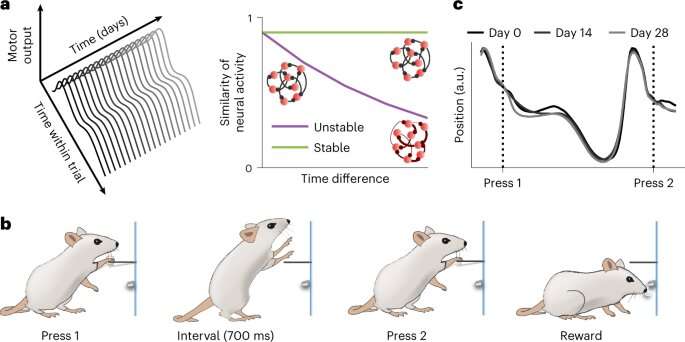Home » Health News »
Study on rodents shows that the activity of single motor neurons is stable over time

While many studies have investigated the underpinnings of the mammalian motor system (i.e., the collection of neural networks that allow mammals to move in specific ways), some questions remain unanswered. One of these questions relates to the ways in which recurring or stable behaviors are maintained in the brain.
Some theories and research findings suggest that the neural activity underlying stable behaviors is itself very stable. Others, however, hinted at the possibility that the activity of individual motor neurons might change considerably over time, despite the production of similar behavioral patterns.
Researchers at Harvard University have recently tried to move toward the resolution of this long-standing debate, by observing the behavior and neural activity of rodents. Their findings, published in Nature Neuroscience, suggest that the activity of single neurons in brain regions associated with movement and physical behavioral patterns is highly stable over time.
“Stability at the level of single neurons is not required in a highly degenerate system like the brain, where many different activity patterns can yield the same output,” Bence P. Ölveczky, one of the researchers who carried out the study, told MedicalXpress. “The notion that neural representations of behavior drift in output-invariant subspaces is widely accepted. But is it so, or has the brain found of way of stabilizing activity at the level of single neurons?”
To test their hypothesis, the researchers had to record their rodents’ brain activity over long periods of time as they performed very stable behaviors. Ölveczky’s lab routinely trains rats to produce complex “dances” or behavioral patterns that, once learned, are very stable. Therefore, the team simply record the activity of individual motor-related neurons over long periods of time as the rats performed these stable behaviors.
“We developed a system that allows us to record from the very same neurons continuously over weeks,” Ölveczky explained. “To remove any source of variability that could confound our experiments, our animals performed the same behavior at the same time of day in the very same box under the same conditions over weeks. The results were striking: the neural activity patterns of single neurons were super stable over weeks of recordings, reflecting the stability of the behavior itself.”
For their findings to be reliable, Ölveczky and his colleagues had to examine a very stable and stereotyped behavior comprised of specific movement patterns that can be measured with great precision. They thus taught the rats to complete a simple task in which they were rewarded for pressing a lever in a temporally precise sequence.
Over time, their rats learned intricate and idiosyncratic movement patterns that ultimately allowed them to solve the task and gain their water reward. These patterns could be compared to the stable movement patterns that humans can learn throughout their life, such as serving in tennis or volleyball.
“We found that the patterns learned by our rats became highly stable over months, and we recorded the activity from the same cells over weeks under very regimented conditions, as explained above,” Ölveczky said. “We also used an innate behavior, the wet-dog shake, that is highly stereotyped and that has a structure that we can measure precisely. I think that our study settles an important question about how stable behaviors and memories are maintained.”
Overall, the recent work by Ölveczky and his colleagues suggests that the brain maintains stable and consistent behaviors by “freezing” the activity patterns of single neurons. This is aligned with the distinct the idea, suggested by prior work, that neural activity can drift around as long as its projections onto relevant control units (so-called “output units”) is stable.
“While our work establishes the phenomenon of single-neuron stability in stable behaviors, how such activity patterns are maintained in circuits that are constantly remodeled by new experiences and other processes remains a mystery,” Ölveczky added. “Ensuring such stability likely requires an active process which we would like to understand. We would also like the animals that maintain a stable behavior to be challenged to learn other similar behaviors, using the same neural circuits, then explore whether such ‘multi-tasking’ introduces instabilities and interference across behaviors.”
More information:
Kristopher T. Jensen et al, Long-term stability of single neuron activity in the motor system, Nature Neuroscience (2022). DOI: 10.1038/s41593-022-01194-3
Journal information:
Nature Neuroscience
Source: Read Full Article


